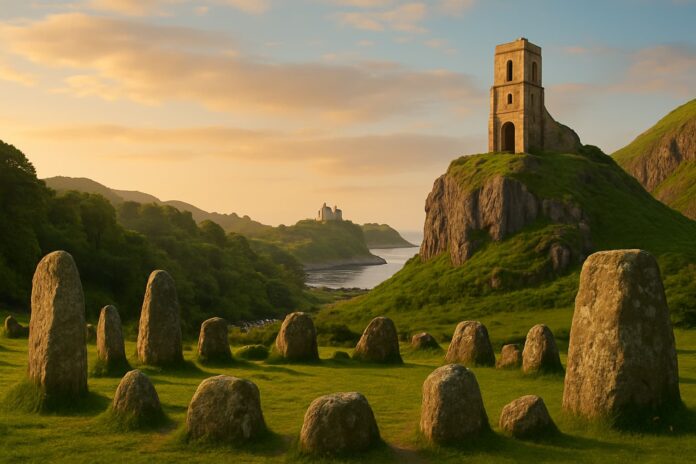From mysterious standing stones and ancient battlegrounds to enchanted waterfalls and fairy-filled forests, the UK is full of places steeped in storytelling. Whether you’re exploring dramatic coastlines, misty glens or medieval ruins, many landscapes across the country feel alive with myth and memory. These twelve magical locations prove that folklore is woven deeply into Britain’s identity — and still waiting to be explored.
Introduction
Travelling through the United Kingdom is a reminder that history and legend often overlap. In many places, the stories are just as captivating as the landscapes themselves. Tales of giants, witchcraft, lost kings and enchanted creatures have been passed down for centuries — not just as entertainment, but as expressions of identity, belonging and belief.
Some of these locations feel mysterious or even eerie, while others are peaceful, spiritual or simply beautiful. What connects them all is the sense that something older — something unseen — lingers in the air. Whether or not you believe these legends literally doesn’t matter; the experience of being there often makes the stories feel remarkably possible.
Below are twelve places in the UK where myth meets landscape — along with helpful travel notes to help you plan your own magical adventure.
1. Tintagel Castle, Cornwall — Arthur’s Legendary Birthplace
Tintagel Castle clings to a rugged headland overlooking the wild waves of the Atlantic Ocean. Often named as the birthplace of King Arthur, this dramatic ruin blends history with legend. Below the castle lies Merlin’s Cave, where sea tides echo and the rock walls shimmer with moisture. The views are breathtaking and the atmosphere feels ancient — as though the land remembers the tales told about it. Whether you come for the myth, the scenery, or the coastal walk, Tintagel leaves a lasting impression.
⭐ Why Visit?
A striking combination of coastal beauty and Arthurian mythology — great for photography and storytelling lovers.
🧭 Travel Tips
- Wear good walking shoes — the paths are steep and exposed
- Book tickets ahead, especially in summer
- Visit early morning or late afternoon for fewer crowds
2. Stonehenge, Wiltshire — Ancient Rituals and Cosmic Alignment
Stonehenge remains one of the greatest archaeological mysteries in the world. Built around 4,500 years ago, the stone circle aligns with the sun during the summer and winter solstice, hinting at astronomical importance. Myths claim Merlin placed the stones using magic or that giants once lived on the plain. Whether viewed from a spiritual or scientific perspective, Stonehenge feels powerful. Standing before its enormous stones creates a sense of curiosity, wonder and connection to an ancient civilisation.
⭐ Why Visit?
To experience one of Earth’s most iconic and mysterious prehistoric structures.
🧭 Travel Tips
- Consider booking a special inner-circle access experience
- Bring layers — Salisbury Plain can be windy
- Explore the visitor centre museum to deepen context
3. Loch Ness, Scotland — Searching for Nessie
Loch Ness stretches across the Highlands like a dark mirror, deep enough to hide legends — and possibly a creature. Reports of the Loch Ness Monster date back centuries, and sightings have ranged from playful speculation to near-serious investigation. Whether Nessie exists or not, the setting feels cinematic: mist rolling across the water, steep hills shadowing the shoreline, and Urquhart Castle overlooking the loch like a watchtower from another age.
⭐ Why Visit?
A beautiful Highland experience with a playful sense of mystery.
🧭 Travel Tips
- Take a boat tour for the best views
- Weather shifts quickly — pack layers
- Pair with a visit to Inverness, Fort Augustus or the Isle of Skye
4. Giant’s Causeway, Northern Ireland — The Work of Giants
Formed of more than 40,000 interlocking basalt columns, Giant’s Causeway feels more like a fantasy design than a natural phenomenon. Folklore explains it differently: the giant Finn McCool built it as a pathway to Scotland — some say for battle, others for love. The dramatic coastline, ocean spray and geometric stone steps make this site both magical and visually stunning. It’s a rare place where myth and geology are equally interesting.
⭐ Why Visit?
For incredible natural formations connected to one of Ireland’s most famous legends.
🧭 Travel Tips
- Avoid midday crowds — sunrise and sunset are best
- Rocks can be slippery; wear sturdy footwear
- Combine with the Dark Hedges or Carrick-a-Rede rope bridge
5. Glastonbury Tor, Somerset — Home of Avalon
Glastonbury Tor rises unexpectedly from the flat Somerset Levels, topped by the remains of St Michael’s Tower. Some believe this was once Avalon — the mythical resting place of King Arthur. Others say the hill sits at the crossing of ancient ley lines, giving it spiritual energy. Climbing the path to the summit offers panoramic countryside views, especially atmospheric in mist or sunrise light.
⭐ Why Visit?
A peaceful and spiritual walk with sweeping views and mystical folklore connections.
🧭 Travel Tips
- The hill is exposed — windproof clothing helps
- Pair your visit with Chalice Well and Glastonbury Abbey
- Best at dawn for serenity and photographs
6. Fairy Pools, Isle of Skye — Waters of the Hidden Realm
At the foot of the dramatic Cuillin mountains lies a series of crystal-clear waterfalls and blue pools. Local folklore links the area to fae spirits and ancient Celtic belief. The water shifts colour depending on the sky — turquoise in sunshine, deep sapphire in shade. Though freezing, some visitors swim, claiming the experience feels cleansing and magical. The landscape is wild, rugged and stunning, offering one of Scotland’s most extraordinary walking routes.
⭐ Why Visit?
An unforgettable natural landscape that feels like something from fantasy fiction.
🧭 Travel Tips
- Arrive early — midday can be busy with tours
- Waterproof shoes are recommended
- Trail can be muddy after rain
7. Puzzlewood, Gloucestershire — A Forest Straight Out of Storybooks
Puzzlewood looks like a fantasy film set — and in fact, it is. With moss-covered rocks, twisting paths, thick roots and small ravines, it has inspired stories for generations and appeared in productions like Star Wars, Doctor Who and Merlin. Folklore suggests this forest once hid fairies and forest spirits. Walking through its winding trails feels like wandering through ancient magic — peaceful, mysterious and perfect for slow exploration.
⭐ Why Visit?
A whimsical woodland walk ideal for families and fantasy lovers.
🧭 Travel Tips
- Terrain is uneven — hiking boots recommended
- Not suitable for wheelchairs or buggies
- Combine with Clearwell Caves or Symonds Yat
8. The Rollright Stones, Oxfordshire — A Witch’s Ancient Spell
This quieter stone circle offers a more intimate experience than Stonehenge. The Rollright Stones consist of three structures: the King’s Men stone circle, the Whispering Knights burial chamber and the lone King Stone. Folklore tells that a witch turned an ambitious king and his army into stone. Visitors often leave ribbons or crystals, giving the site a gentle sense of ritual. It’s peaceful, intriguing and a lovely stop on a Cotswolds route.
⭐ Why Visit?
A mystical yet accessible site with deep pagan and folklore links.
🧭 Travel Tips
- Wheelchair-friendly gravel path
- Bring coins for onsite donation box
- Visit at sunset for a mystical atmosphere
9. Doon Hill, Aberfoyle — A Gateway to the Fairy Realm
Doon Hill is closely tied to the story of Reverend Robert Kirk, a minister who studied fairy folklore in the 1600s. Locals say he revealed too many secrets — and the fairies took his spirit into the hill. Today, trees are adorned with ribbons, charms and handwritten wishes, making the walk both emotional and enchanting. The route is scenic and gentle, offering views of the surrounding countryside.
⭐ Why Visit?
A uniquely spiritual and thought-provoking woodland experience.
🧭 Travel Tips
- Bring biodegradable ribbon if leaving a wish
- Suitable for most walkers
- Combine with Aberfoyle village and Loch Ard
10. St Nectan’s Glen, Cornwall — A Sacred Waterfall Sanctuary
This peaceful woodland walk leads to a stunning 60-foot waterfall cascading through a natural rock arch. The site has long been associated with spiritual healing, Celtic belief and angel legends. The atmosphere is calm and meditative, with moss-covered rocks and flowing water surrounding the trail. The glen feels like a hidden world and remains one of the most peaceful places linked to Arthurian and mystical lore.
⭐ Why Visit?
An atmospheric and soothing destination perfect for quiet reflection.
🧭 Travel Tips
- Muddy after rain — waterproof shoes advised
- Tearoom available near the waterfall
- Best combined with Tintagel Castle
11. Pendle Hill, Lancashire — Witches and Dark History
Pendle Hill is forever associated with the infamous 1612 witch trials, one of the darkest chapters in English history. Mist often clings to the slopes, creating a dramatic and slightly eerie atmosphere. Local ghost tours explore the stories of the accused women and reported hauntings. The hill itself provides stunning countryside views — and a sense of stepping into something ancient and unsettled.
⭐ Why Visit?
A chilling yet fascinating destination for dark history and folklore enthusiasts.
🧭 Travel Tips
- Hike is steep — proper footwear required
- Guided tours available for deeper storytelling
- Combine with Clitheroe or Barley village
12. Dunstanburgh Castle, Northumberland — A Ruin with Ghostly Echoes
Dunstanburgh Castle stands alone on a windswept headland overlooking the North Sea. Legends tell of ghostly knights, tragic battles and restless spirits wandering the ruins. The walk to the castle from Craster is one of the most scenic in the region, with coastal views, seabirds and rugged cliffs. The site feels ancient and brooding, with weathered stones hinting at long-lost stories.
⭐ Why Visit?
A dramatic and atmospheric walk ending at one of England’s most impressive castle ruins.
🧭 Travel Tips
- 1.5-mile coastal walk each way
- Bring windproof layers
- Great paired with Alnwick Castle or Seahouses
FAQs
1. Are these locations suitable for families?
Many of the places in this guide are family-friendly, especially Puzzlewood, Giant’s Causeway, the Fairy Pools and Loch Ness. However, some locations like Pendle Hill, Dunstanburgh Castle and St Nectan’s Glen involve hill walking or uneven terrain, so suitable footwear and planning are essential. Younger children may enjoy interactive tours or legends more than long walks. Always check route difficulty, weather and accessibility beforehand to ensure a comfortable visit for all ages.
2. Is it possible to visit these places using public transport?
Some locations, like Stonehenge, Glastonbury, Inverness and parts of Northumberland, are accessible by public transport, but many require a car for convenience. Rural areas may have limited bus schedules, especially during winter. If you don’t drive, guided tours can be an excellent alternative — particularly in Cornwall, the Highlands and Northern Ireland. Checking local timetables in advance will help you structure your journey effectively.
3. When is the best season to explore these mythical sites?
Spring and early summer offer pleasant weather, blooming landscapes and fewer crowds. Autumn brings dramatic colours that make forests, hills, and stone circles even more atmospheric. Winter can be magical, especially at castles and dramatic coastlines, but weather may limit accessibility. Summer is ideal for the Fairy Pools, Loch Ness and coastal walks, though it’s also the busiest season.
4. Are these places free to visit?
Some locations, such as Doon Hill, Fairy Pools, and Rollright Stones, are free or donation-based. Larger heritage sites including Tintagel Castle, Stonehenge and Dunstanburgh Castle require entry fees, which help protect and maintain them. Parking fees may apply at several outdoor areas, especially national trust or environmentally protected sites. Checking official websites beforehand ensures there are no surprises.
5. Should I believe the legends attached to these places?
Belief isn’t required — curiosity is enough. For many visitors, folklore adds depth, meaning and charm to the landscape. Whether the stories are symbolic, exaggerated or partially true, each one reflects the imagination and beliefs of past communities. You can enjoy these legends as history, cultural storytelling or simply as fun travel context.
6. Are guided tours recommended for these locations?
Guided tours can be especially valuable for places rich in history and storytelling, such as Pendle Hill, Loch Ness, Tintagel and Giant’s Causeway. Experienced guides share local knowledge, stories, archaeology and hidden folklore you may otherwise miss. Self-guided visits still offer plenty of enchantment, especially at scenic or remote stops.
7. Can I photograph and drone-fly at these sites?
Photography is welcome at almost every location, though drone rules vary. Heritage sites, national parks and protected wildlife areas often require special permission for drone use. Large bodies like English Heritage, National Trust, and Historic Scotland have strict guidelines. When in doubt: check signage or official websites.
Conclusion
Exploring these magical places reveals just how deeply myth, identity and storytelling are rooted in the UK landscape. Each location blends natural beauty with the imagination of the generations who lived here before. Whether you’re drawn to legends, dramatic landscapes or simply something unusual, these destinations offer unforgettable experiences.
So next time you’re planning a UK adventure, look beyond the typical tourist stops — and consider following the stories instead. You may find that the land remembers more than we expect.




























